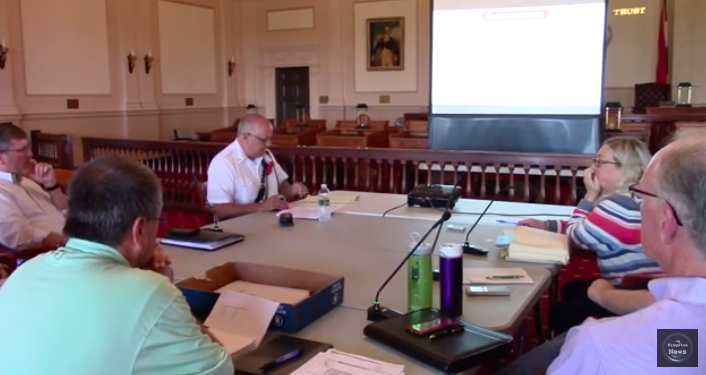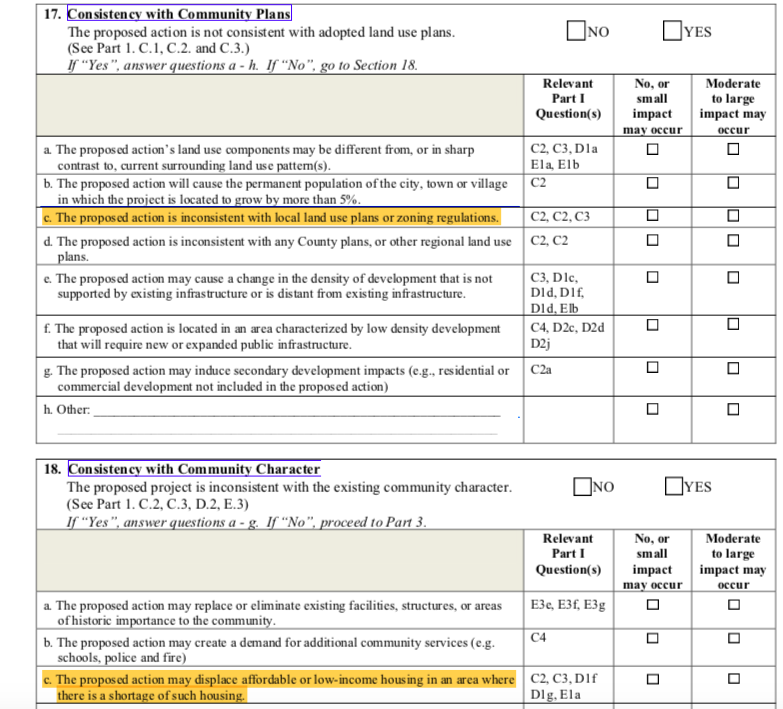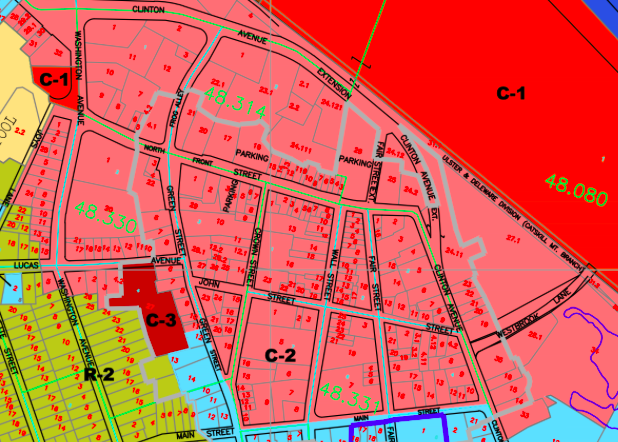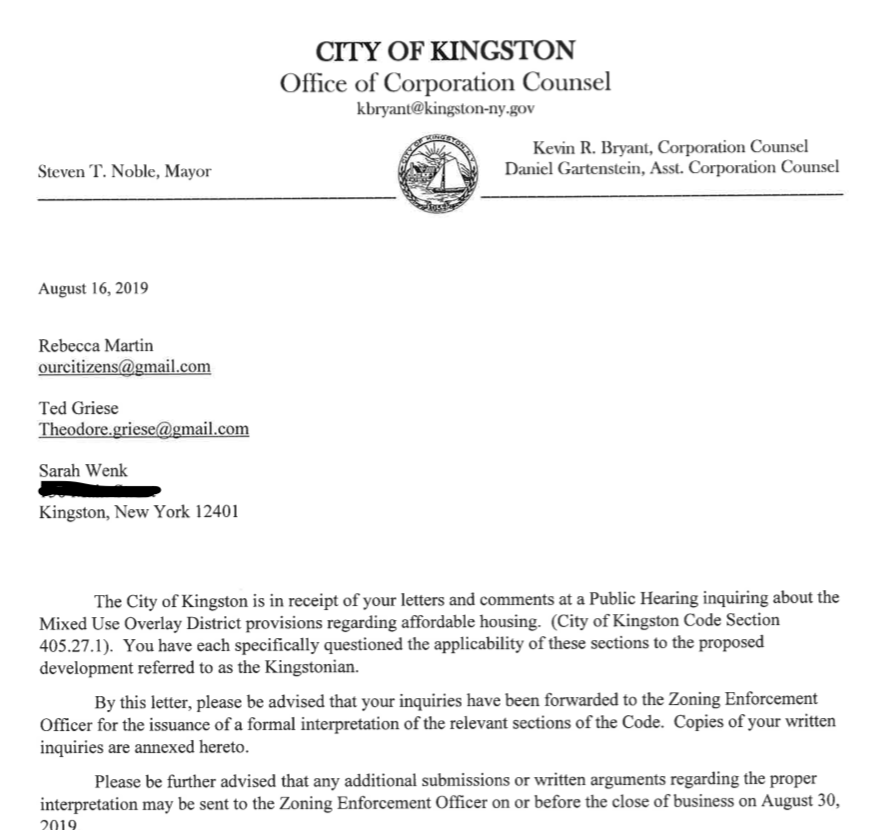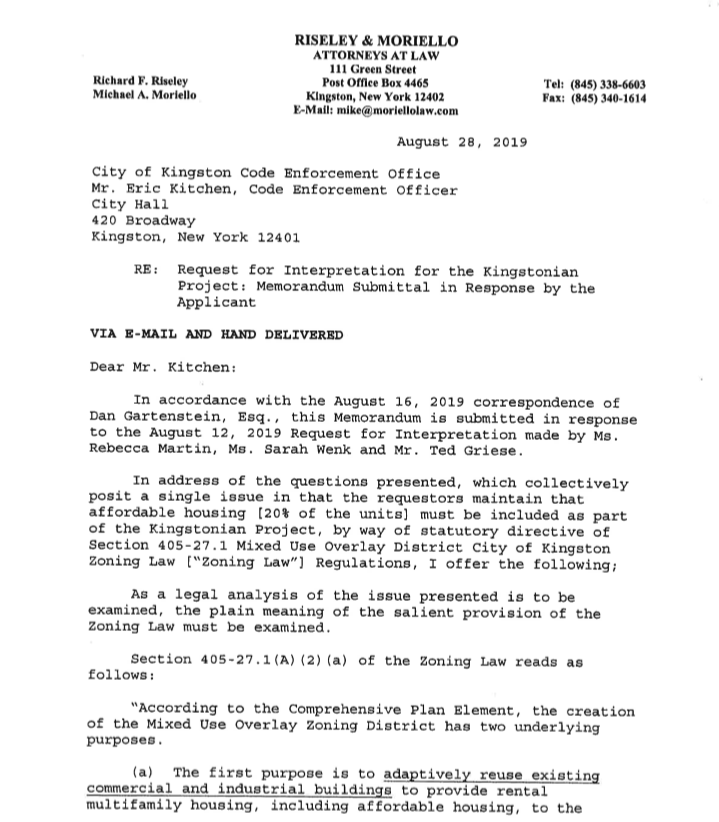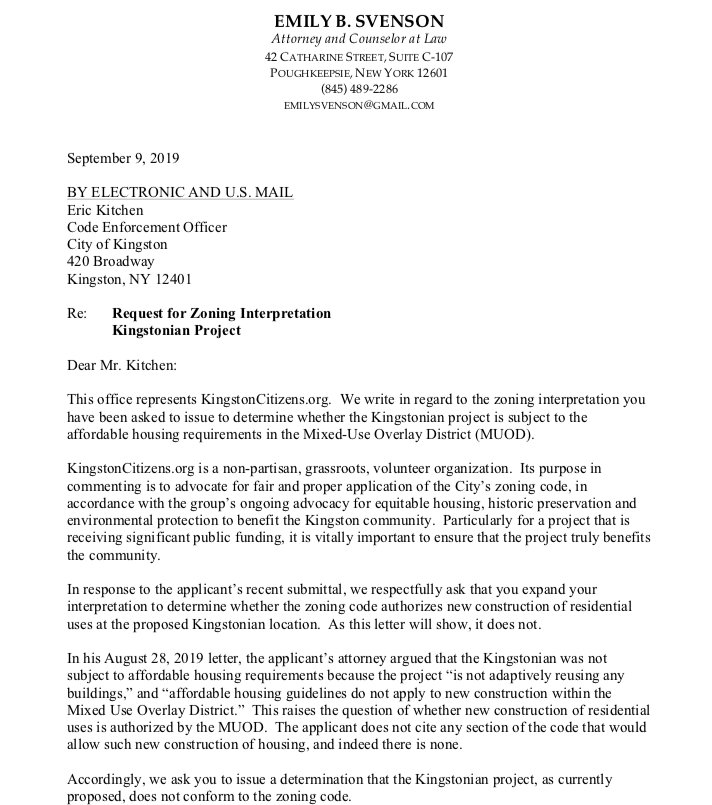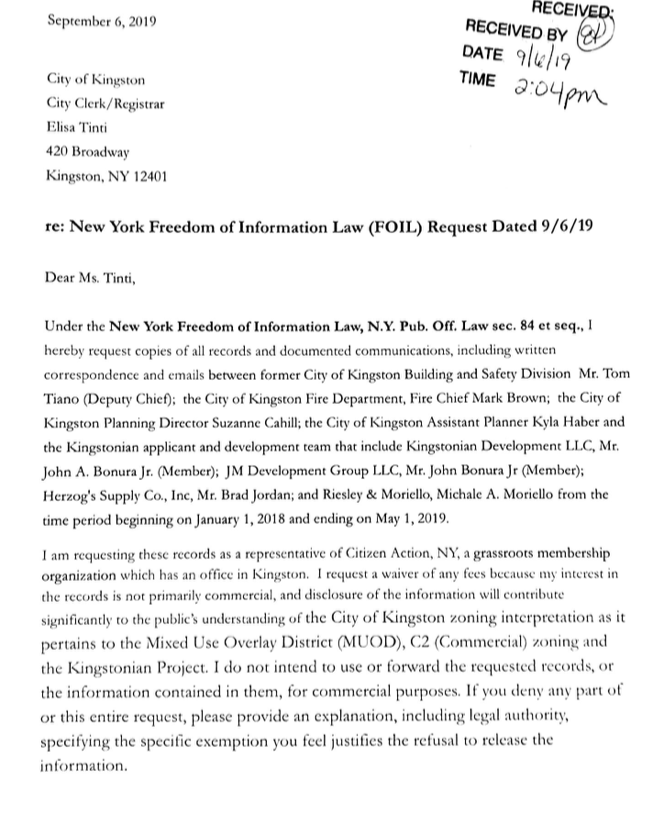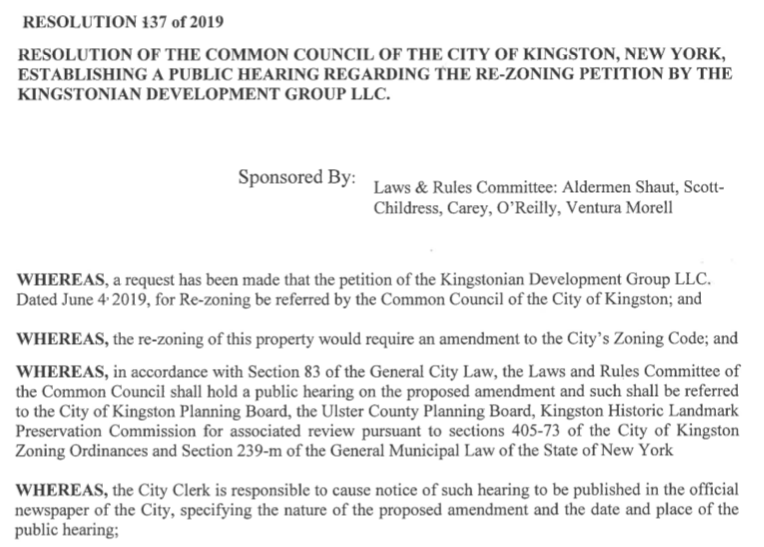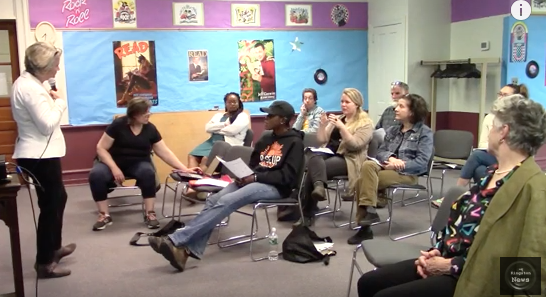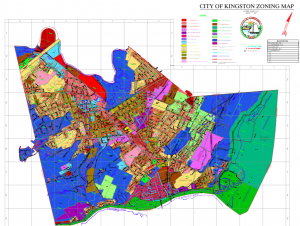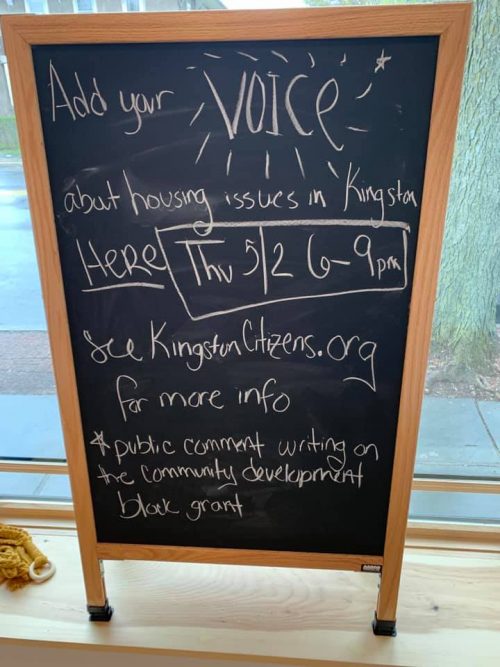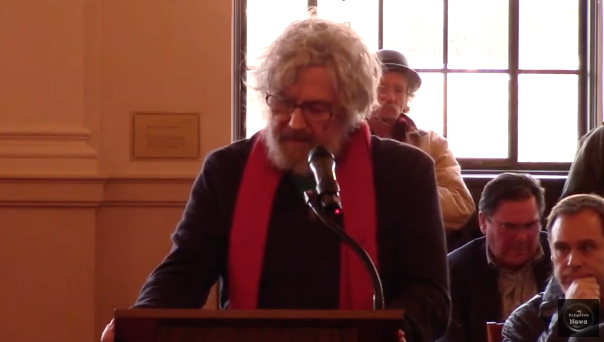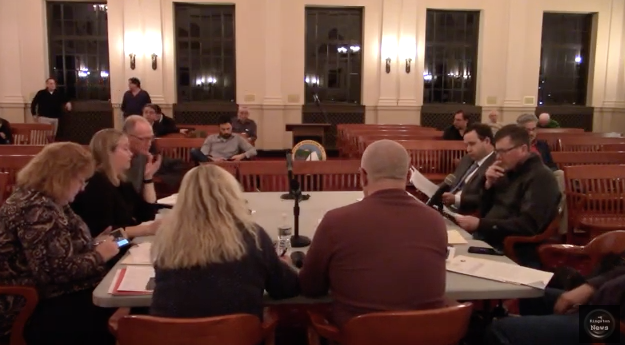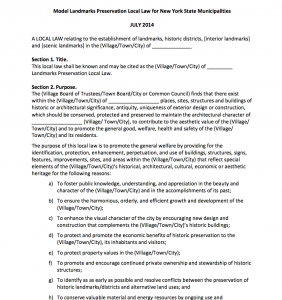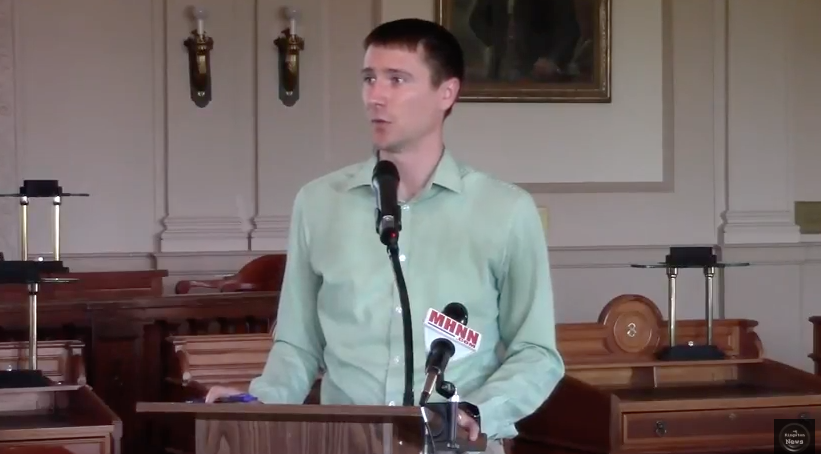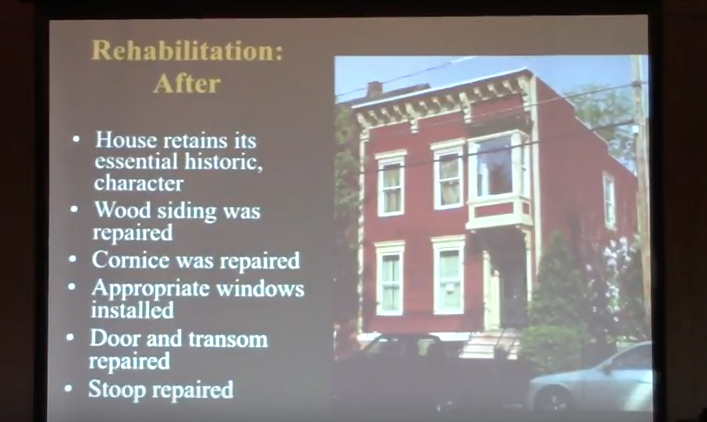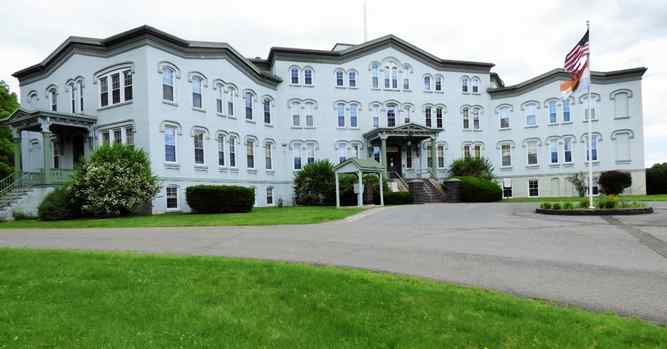Group Editorial by Lynn Eckert, Tanya Garment, Ted Griese, Laura Hartmann, Rebecca Martin, Marissa Marvelli, Melinda McKnight, JoAnne Myers, Giovanna Righini, Rebecca Rojer, Rashida Tyler, Sarah Wenk, Theresa Lyn Widmann
“…in a democracy if it’s going to work, people have to feel comfortable standing up and speaking their mind and speaking truth to power. If you are intimidated in the process…you become increasingly thoughtful and hesitant in the way you enter into public debate and that’s not good for anyone.” – Lynn M. Eckert, Ulster County Legislator and Professor of Political Science at Marist College.
In recent months, not only have City of Kingston officials been misleading the public in the review process for the proposed Kingstonian but the Mayor’s lawyers have singled out select individual citizens in an attempt to silence their advocacy for a transparent and inclusive planning process.
At an August public hearing two citizens – Ted Griese and Sarah Wenk – delivered verbal testimony simply urging the Common Council to have a crystal clear understanding of the zoning law before amending it, which would allow the Kingstonian project to move forward. They, along with Rebecca Martin (lead organizer of KingstonCitizens.org), were the three citizens singled out in the Corporation Counsel’s letter regarding the City’s zoning interpretation, despite the fact that others in the community had also raised the question in written comments to their Council representative.
It was shortly after that hearing that the Corporation Counsel’s office sent the troubling letter as an email attachment to the three private citizens identified above stating that the City was initiating a zoning interpretation process centered on the “Mixed Use Overlay District (MUOD) provisions regarding affordable housing.” The letter stated that the City was in receipt of their comments from the public hearing and that they had been sent to the City’s zoning officer for the issuance of a “formal interpretation of the relevant sections of the Code.” The letter never explained why only these citizens had been singled out among all of the other commentators.
The attorney representing the Kingstonian applicant submitted his written interpretation of the zoning as it pertains to the affordable housing requirement, concluding that “…there has been no waiver or violation of any zoning law 20% affordable housing requirement with respect to issuance of a Special Use Permit, as affordable housing guidelines do not apply to new construction within the Mixed Use Overlay District under the City of Kingston Zoning Law.”
Given the disorganized and opaque Planning Board process and the singling out of individual citizens by the Mayor’s lawyer, KingstonCitizens.org felt compelled on behalf of the public to reach out to an attorney to clarify the question before the zoning enforcement officer – even if it meant participating in a process that they and the citizens had never sought. The applicant argued that no affordable housing was required because it is not adaptively reusing buildings. However, the MUOD is premised on adaptive reuse (which must include affordable housing) and does not authorize new construction of residential apartments. Environmental and land use attorney Emily Svenson asked that the City expand its interpretation “to determine whether the zoning code authorizes new construction of residential uses at the proposed Kingstonian location,” reiterating the question asked by members of the community.
In response to Svenson’s letter, chief Corporation Counsel, Kevin Bryant, who is appointed by the Mayor, sent a reply on September 12th, requesting that, since KingstonCitizens.org was “represented” by counsel, all communications from certain named citizens regarding the project go through counsel only. It also stated that members of city boards and commissions had been instructed to no longer speak to advisers of KingstonCitizens.org. Specifically, it read:
“As you are likely aware, the Kingstonian project is currently before numerous City Boards and Commissions and the Kingston Common Council. Your client has continued to assert an interest and a public position regarding each of the pending applications.
We are hereby requesting that in order to comply with the Code of Professional Responsibility, henceforth, all communications regarding the Kingstonian with officers of Kingstoncitizens.org, including but not limited to Rebecca Martin, Tanya Garment, Marissa Marvelli, Jennifer Schwartz Berky and Lynn Eckert, shall be through counsel.
Please be further advised that City Officials and Board and Commission members involved in the review of the Kingstonian project have also been advised that they are not to speak directly to these individuals as they are represented by counsel.“
Svenson swiftly responded that the City’s request was an infringement on individuals’ First Amendment rights and pointed out the Counsel’s misunderstandings:
“…Please be aware that KingstonCitizens.org is a grassroots, volunteer organization and not a corporation. The individuals named in your letter are simply volunteers acting as organizers or advisors; they are not staff or officers. There is no justification for limiting their ability to communicate as individuals with their government.”
Furthermore, Svenson noted that:
“The Rules of Professional Conduct applicable to attorneys do not limit the rights of represented parties to communicate with one another. Particularly in the context of government, it is essential for citizens to be able to speak freely on matters of public interest pursuant to their rights under the First Amendment.”
If the City’s Corporation Counsel had reached out to Svenson prior to sending his letter, he would have understood that her representation in this case was limited solely to commenting on the City’s zoning interpretation for the Kingstonian project. Unfortunately, he went beyond the understandable need to protect the City and seized on the opportunity to cut off public discourse by advising elected and appointed officials that they should not speak to the citizens, directly undermining public dialog. The City took the approach that it was managing an adverse litigation-type situation rather than a participatory public process. It’s not the first time they have done so. The City has on many occasions tried to steer the process in a certain direction rather than allowing the process to guide its review.
From the beginning of the Kingstonian SEQR process, residents – and particularly those outspoken women who are civically engaged – have been intimidated, bullied, and mistreated by both members of the applicant’s team and city staff. They have been accused of having political agendas; punished for being professionals in their trades; shamed for asking tough questions; and called enemies of progress for demanding an inclusive process.
All the while, our Mayor, with the power to hire and fire city staff and appoint all members of boards, committees, and commissions, remains silent about this undemocratic and bullying behavior. We live in a democracy not an authoritative regime, where citizens have First Amendment rights to play an active role in their government.
We are daylighting these antidemocratic actions today because they erode the public trust and confidence in our local government. Politicizing processes and institutions is the most effective means for discouraging citizen engagement, the evidence of which we are already seeing. No one should have to hire a lawyer to ask questions that government officials may dislike.
We are in the midst of another election season and as usual, elected officials are again boasting about how well they make citizens feel “heard.” To us, it rings particularly hollow. In this instance, the Mayor’s lawyer used the Rules of Professional Conduct for lawyers as a pretext to chill the speech of citizens with whom the administration disagreed. If the Mayor is truly committed to “hearing” citizens, he should address the silencing tactics within his own administration.
While reasonable people may disagree about how to interpret and apply the zoning law to the Kingstonian project, we can all agree that actions taken on the part of the Mayor’s lawyer to intimidate, single out, and silence citizens – particularly female citizens – engaging in their right to free speech is simply unacceptable. With officials committed to a fair, open, inclusive, and transparent process such undemocratic tactics would be unnecessary.

